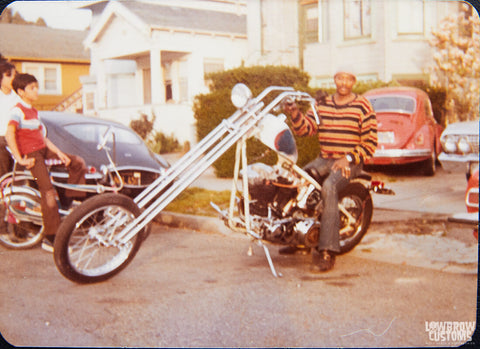TABLE OF CONTENTS
- What Happened in The Harley-Davidson's AMF Years?
- Challenged by Less Expensive and More Refined Japanese Competitors
- Hard Times When Build Quality and Reliability Deteriorated
- Some Bright Spots of Amf Harley Davidson Motorcycles From 1960s to 1971
- The Italian-made Aermacchi Motorcycles
- The 350 CC SX-350 Model in 1971
- The Harley-Davidson Golf Carts
- The Company's Most Influential Products - the FX Super Glide in 1971
- AMF Harley Davidson Motorcycles from 1973 to the end of 1981
- The Iconic Models Bicentennial Liberty Edition in 1976
- Rarest and Most Controversial Harley-Davidson Models - The Confederate Edition Series in 1977
- Café Racer Motorcycle - the XLCR in 1977
- The XR-750 Racing Bike Between 1972 and 1980
- The FXS Low Rider in 1977
The story of Harley-Davidson in the 1970s begins with an unexpected twist. AMF (American Machine and Foundry), a company famous for bowling balls, stepped in to buy the legendary motorcycle maker in 1969. What followed was twelve years of dramatic change. The factory lines produced everything from innovative 650cc cruisers to experimental dirt bikes. Meanwhile, competitors like Honda and Kawasaki were reshaping the American motorcycle market. This period gave birth to both legendary machines like the 1973 FX Super Glide and unique creations like Aermacchi Harley-Davidson lightweights.
Lowbrow Customs has spent years working with these 70s Harley-Davidson motorcycles. We know every bolt and story from the AMF years. Let's explore how this chapter changed not just who owns Harley-Davidson, but the spirit of American motorcycling itself.
When Did AMF Buy Harley-Davidson?
By the 1960s, however, Harley-Davidson was facing serious financial challenges. This iconic American motorcycle brand, long revered for its homegrown craftsmanship, had reached a point where outside help was needed. But who bought Harley-Davidson during this turbulent era, and what would it mean for its American heritage?
In 1969, AMF stepped in to purchase Harley-Davidson, effectively becoming its new owner. AMF stands for American Machine and Foundry, an American manufacturing conglomerate known for producing everything from bowling equipment to recreational products.
The move ensured Harley-Davidson remained under American ownership, yet the changes that followed were profound. With AMF at the helm, cost-cutting measures and altered production methods ushered in a decade of tension and transformation. As we’ll see next, the 1970s would test Harley-Davidson’s identity like never before—ultimately, this era would set the stage for the company’s return to its visionary leaders and the rebirth of its classic American spirit.
What Happened in The Harley-Davidson's AMF Years?
During the ’70s, with the American economy in a recession, Japanese bikes like Yamaha and Honda were proving to be very popular with consumers. This created significant tension within the company, which led to the company coming back to its original owners in the 1980’s. Use a Harley VIN lookup to check specific AMF-era details on a vintage Harley.
In February 1981, a group of Harley-Davidson senior executives purchased Harley-Davidson from AMF. Driven by passion and a true belief in the brand, the executives were able to rescue the company from debt.
While AMF’s arrival did save Harley-Davidson from impending bankruptcy, the AMF years were arguably the most not-so-fond period in Harley-Davidson’s history. While there were, and still are, plenty of fans of the AMF-era Harleys, many Harley purists weren’t too thrilled with the idea of a sporting goods manufacturer producing the classic American motorcycle, especially given the shifts in Harley engine types during that time.
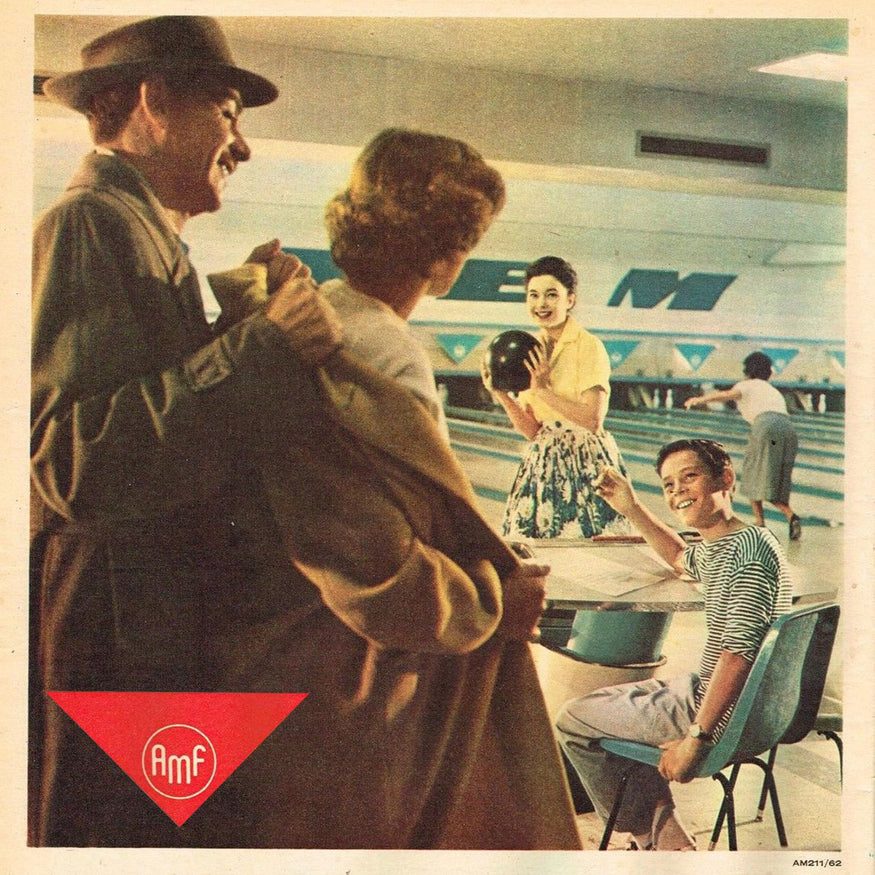
AMF was first highly known for their bowling equipment and the sporting goods.
Challenged by Less Expensive and More Refined Japanese Competitors
During the years that AMF owned Harley-Davidson, various Japanese, British, German, and Italian motorcycle manufacturers were also producing bikes that the motorcycling public was very receptive to. In addition to producing the smaller bikes that they had made for years, these companies began producing larger street and touring bikes.
The Honda 750, the Yamaha 650, Triumph 650, and Kawasaki Mach III cycles were providing some real competition for the Harleys that were being produced under the watch of AMF.
The Honda 750 models in particular, were proving to be big sellers, and the bikes were starting to be customized as choppers.
Hard Times When Build Quality and Reliability Deteriorated
There were rumblings of discontent concerning the workmanship and reliability of the AMF-era Harleys among some owners of the machines. It was commonly believed that the company sold out to corporate America, causing the overall quality and image of the machines and the brand to dip lower than ever before.
AMF did keep the Harley name going through those lean years, though. Even though the sales competition from the foreign manufacturers was intense, Harley-Davidson remained as the top-selling brand of heavyweight motorcycles.
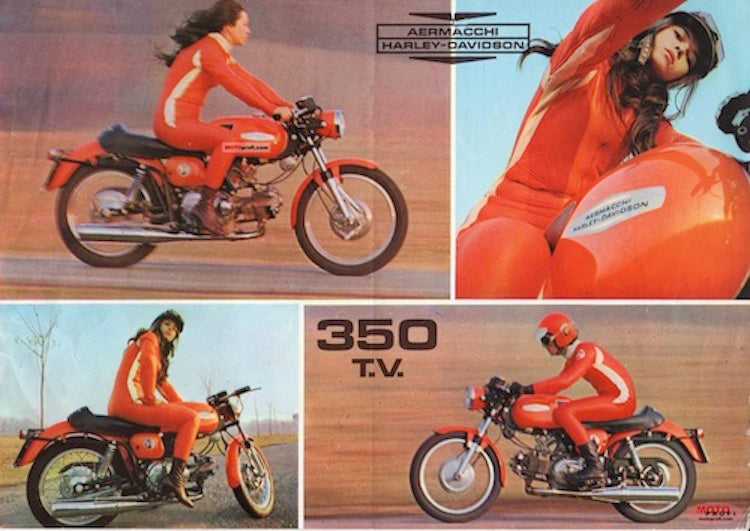
Vintage ad for an Aermacchi 350 / Harley-Davidson.
Some Bright Spots of Amf Harley Davidson Motorcycles From 1960s to 1971
While the AMF years often draw criticism, they weren't without their bright spots. In fact, these early years saw some fascinating innovations from the Milwaukee giant. From Italian-built Aermacchi motorcycles to the game-changing FX Super Glide, this period marked Harley-Davidson's bold experiments with new markets and designs. Let's look at some standout machines and surprising ventures that emerged during these transformative years.
The Italian-made Aermacchi Motorcycles
Beginning in the early 1960s, Harley-Davidson produced a line of smaller bikes that were actually Italian-made Aermacchi motorcycles that were redesigned and branded as Harleys. AMF continued to produce these models until 1978, when the division was sold to Italian motorcycle company Cagiva.
The 350 CC SX-350 Model in 1971
The 65 cc M-65, the 100 cc Baja, and the 125 cc Rapido models were all produced by Harley-Davidson until 1972. The 250 cc Sprint model cycle that was produced throughout most of the 1960s was essentially reintroduced as the 350 cc SX-350 model in 1971.
The Harley-Davidson Golf Carts

Ah, what every motorcycle enthusiast needs in their life, a Harley-Davidson golf cart.
AMF also continued to produce a pre-existing line of Harley-Davidson three-wheeled and four-wheeled golf carts during the years that it ran the company.
The Company's Most Influential Products - the FX Super Glide in 1971

Harley-Davidson's 1200cc Super Glide FX.
In 1971, the FX 1200 Super Glide made its first appearance. The first custom/cruiser machine produced by Harley-Davidson, this bike was a hybrid Sportster/big twin model. Although sales of this bike were somewhat sluggish at first, the Super Glide and its subsequent variations proved to be quite popular with motorcycle consumers.
Production of Harley-Davidson snowmobiles also began in 1971, and continued through 1975.
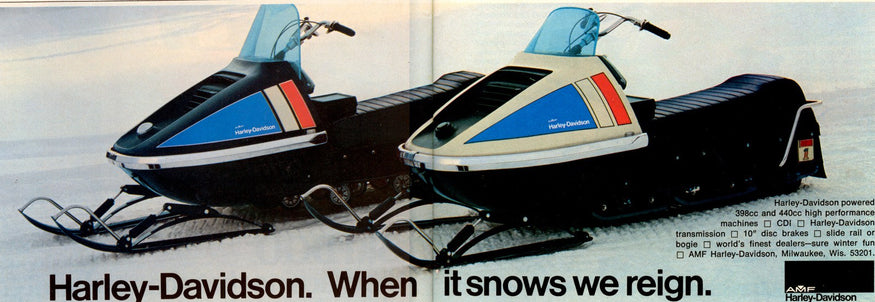
Yup, they made Harley-Davidson snowmobiles!
AMF Harley Davidson Motorcycles from 1973 to the end of 1981
As the 70s rolled on, Harley-Davidson under AMF took some bold swings at the motorcycle market. The opening of their new York assembly plant in 1973 marked the beginning of an era filled with memorable limited editions and experimental models. From patriotic celebrations to controversial choices, these years saw some of the most distinctive - and rare - motorcycles ever to wear the bar and shield. Let's explore the unique bikes that emerged during this pivotal period, including some that still stir passionate debates among collectors today.
The Iconic Models Bicentennial Liberty Edition in 1976
A big step forward for Harley-Davidson occurred in 1973 when the company opened a new assembly plant in York, Pennsylvania.
Designed to commemorate America's bicentennial, Harley-Davidson released a limited edition line of bikes called the Bicentennial Liberty Edition in 1976. With their special commemorative decals, these bikes were generally well-received by their owners and motorcycle reviewers alike.
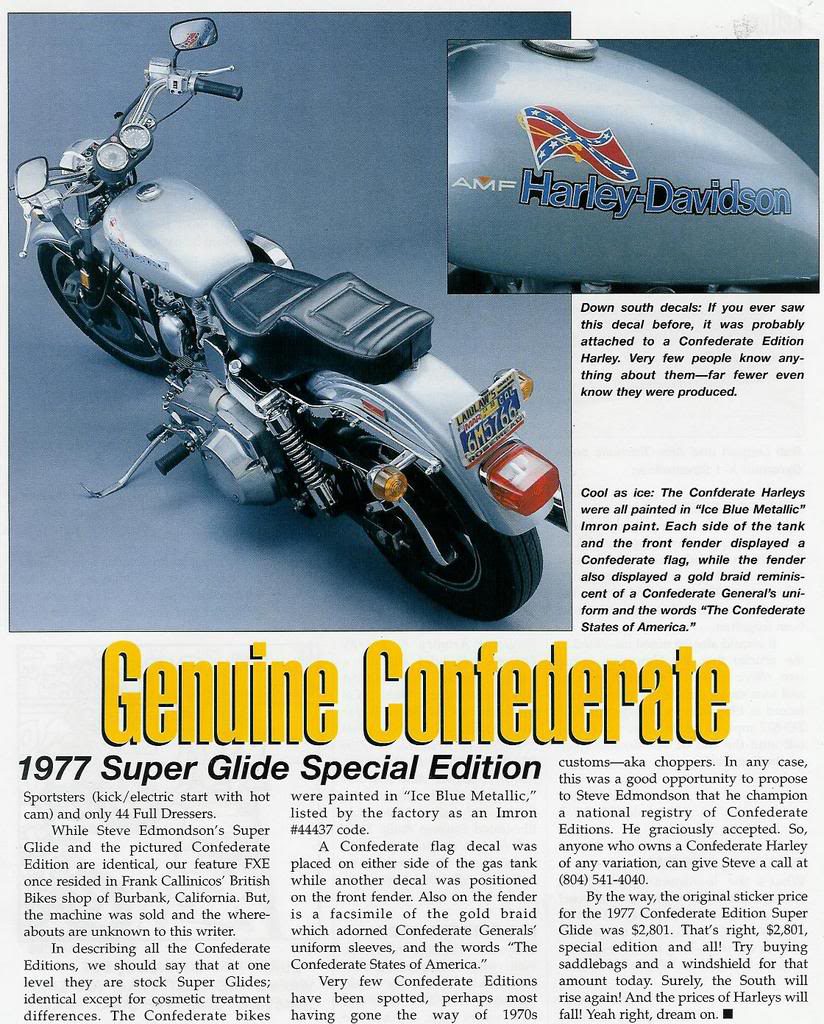
Only 650 Confederate Editions were ever produced between the different models Harley-Davidson had to offer at the time.
Rarest and Most Controversial Harley-Davidson Models - The Confederate Edition Series in 1977
One of the rarest and most controversial Harley-Davidson models was produced during the year following the bicentennial. In 1977, AMF-Harley produced a limited edition line of bikes known as the "Confederate Edition" series.
The "Confederate Edition" line consisted of silver-painted Sportsters, Electra Glides, and Super Glides that were factory-accessorized with motorcycle decals of the rebel flag. Between the different models, a total number of approximately 650 of these bikes were produced.
After a civil rights complaint was lodged against Harley-Davidson for its use of a culturally insensitive symbol, the company decided to stop using the Confederate flag symbol on its products, including the "Confederate Edition" models.
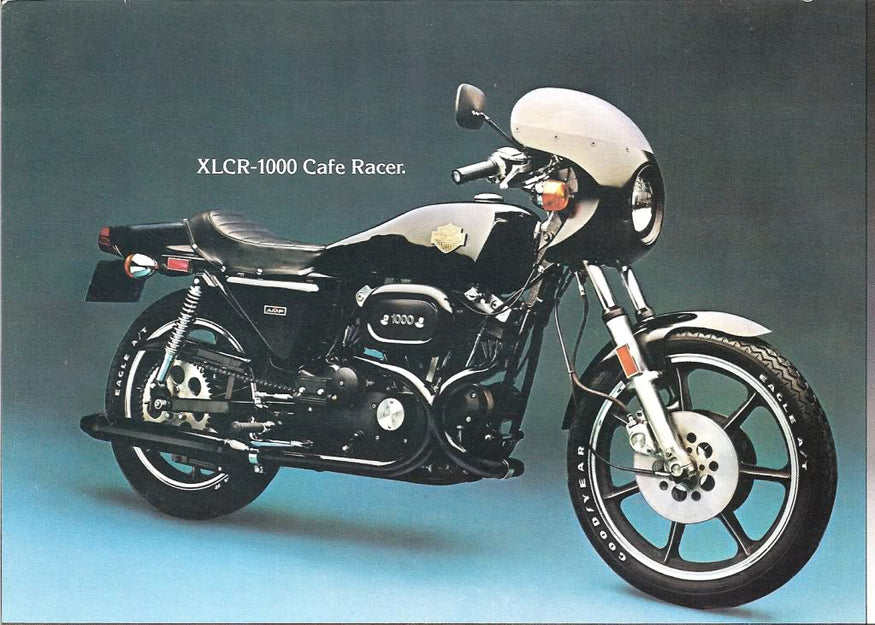
The Harley-Davidson XLCR-1000 was released in 1977.
Café Racer Motorcycle - the XLCR in 1977
Harley-Davidson also introduced a 1000 cc cafe racer model known as the XLCR in 1977. Although the model is popular with collectors these days, it was largely ignored back when it was released. Sales figures for the XLCR were low, and the model was discontinued in 1979.
The XR-750 Racing Bike Between 1972 and 1980

Evel Knievel going down hard and his Xr750 following right behind after a successful 90 mph jump over 13 buses at Wembley Stadium - 1975.
The XR-750 racing bike debuted in 1970, then was reintroduced with an all-new alloy engine in 1972. The XR-750 was produced in several model years between 1972 and 1980. This AMF-era Harley model was the type of motorcycle that stunt rider Evel Knievel utilized for his motorcycle jumps in the 1970s. After 1980, with the history of the Harley-Davidson Evolution Engine only the engine from this dirt track racing bike model became available.
The FXS Low Rider in 1977
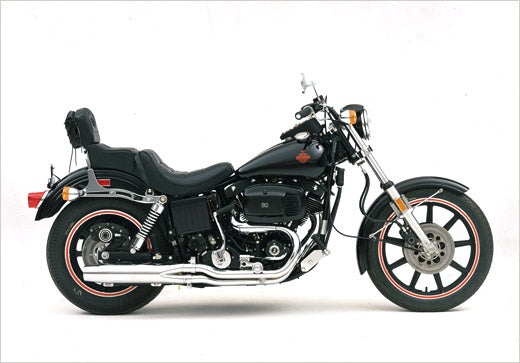
Harley-Davidson's FXB Sturgis model was released in 1980.
Among the other notable models that were produced by Harley-Davidson during the AMF years were the FXS Low Rider in 1977, the "Fat Bob" in 1979, and the 80 cubic-inch FXB Sturgis model in 1980.
AMF Sold Harley-Davidson in 1981
The AMF association with Harley-Davidson motorcycles ended in 1981 when AMF sold the company to a group of investors including Willie G. Davidson, the grandson of company co-founder William A. Davidson.
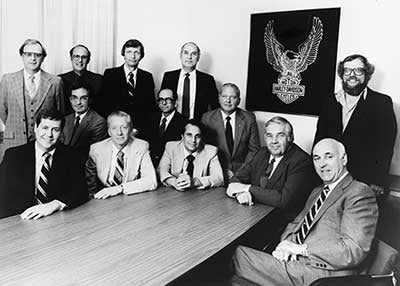
The Harley-Davidson buy back from AMF meeting happened in 1981.
The new owners of the company reinvigorated Harley-Davidson with a sense of rebirth and independence that hugely boosted company morale. Having had an opportunity to free itself from a larger corporate owner, Harley-Davidson was back, with a whole new philosophy and quest for excellence.
 Lowbrow Customs' AMF Motorcycle Grips (Ain't Motorcycles Fun?), inspired by 1970's era Harley-Davidsons.
Lowbrow Customs' AMF Motorcycle Grips (Ain't Motorcycles Fun?), inspired by 1970's era Harley-Davidsons.
What Happened in The AMF years' Harley-Davidson Signatures?
Many of the fuel tanks on Harley-Davidsons made during the AMF years featured vibrant three or four-color designs. A solid-color background on these tanks is usually accented by a rectangular Harley-Davidson name plate, and two or three different-colored horizontal lines.
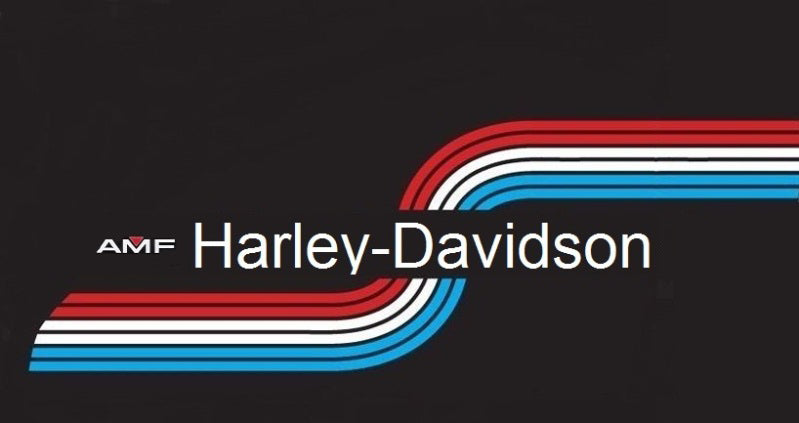
That signature AMF look to most gas tanks.
Nowadays, those AMF-era fuel tanks are much-desired items by Harley owners and collectors of accessories related to the motorcycle company. To this day, a big market exists for all types of AMF-era Harley-Davidson motorcycle parts, accessories, and advertising materials.
These days, the AMF company is focused on operating more than 240 bowling centers across America.
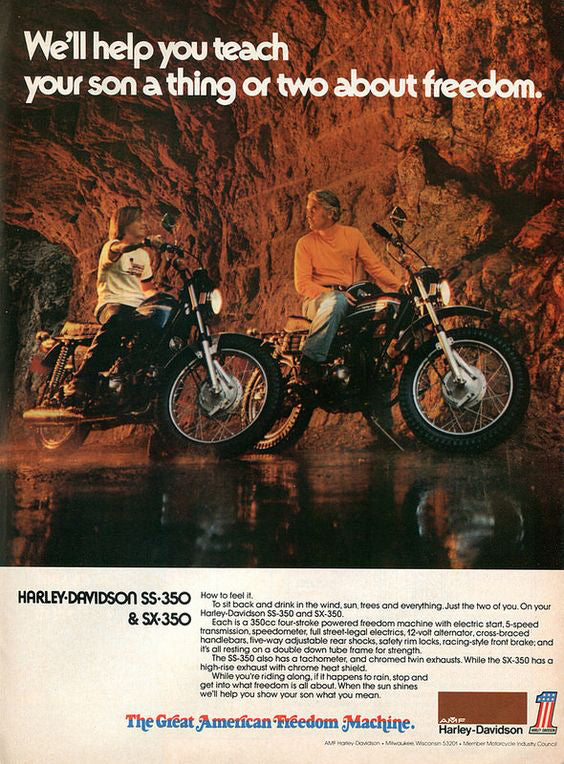
Start'em young.
As with most things in life, there are pluses and minuses when it comes to the years that AMF owned Harley-Davidson. Sure, there are some people who will insist that the motorcycles that were made by Harley-Davidson during the AMF years were not as well-made as Harley Davidson models from other eras.
There are lots of other people, however, who have owned, or still do own AMF-era Harleys, and are very happy with their machines. One thing is for sure, the years that Harley-Davidson was owned by AMF were interesting times.

"One thing is for sure, the years that Harley-Davidson was owned by AMF were interesting times."
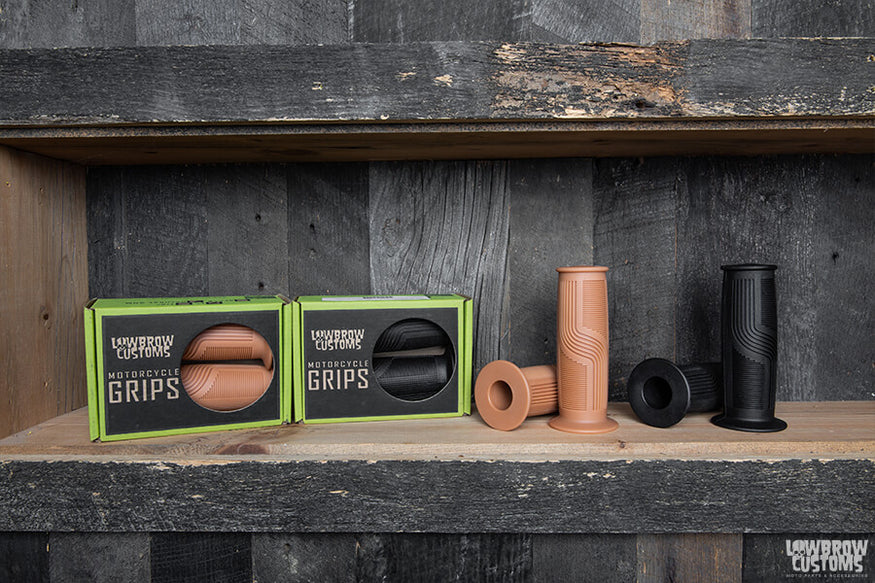 New Lowbrow Customs AMF Motorcycle Grips - Get a Grip today!
New Lowbrow Customs AMF Motorcycle Grips - Get a Grip today!

The AMF years left a lasting mark on Harley-Davidson. These twelve years changed how motorcycles were built, sold, and ridden in America. Each 70s Harley tells a unique story of innovation and challenge. Some riders criticized AMF's ownership. Others found beauty in these experimental years. The truth lies in the machines themselves. Walk around any 1976 model, and you'll spot features that influenced modern bikes. Study an AMF-era tank, and you'll see design elements still copied today. These motorcycles weren't just products of their time. They were stepping stones to the future of American motorcycling. That's why collectors still seek them. That's why builders still study them. And that's why the story of Harley-Davidson in the 70s remains relevant for every rider today.
Related Products









